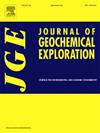Geochronology, petrology and Sr-Nd-Hf isotope geochemistry of the newly discovered Narenguole magmatic Ni-Cu sulfide prospect, Eastern Kunlun Orogenic Belt, Qinghai Province, NW China
IF 3.3
2区 地球科学
Q1 GEOCHEMISTRY & GEOPHYSICS
引用次数: 0
Abstract
Since the discovery of the giant Xiarihamu magmatic Ni-Cu-Co sulfide deposit in the Eastern Kunlun orogenic belt (EKOB) in 2011, more and more mafic-ultramafic intrusions containing sulfide mineralization has been found in this area, indicating that the magmatic sulfide deposit has great exploration potential. Recently, magmatic sulfide mineralization of economic significance has been found in the I intrusion of the Narenguole (NRGL) magmatic sulfide prospect in the eastern segment of EKOB, with Cu grade of 0.59 wt% and Ni grade of 2.07 wt%, showing great prospecting potential.
However, the age, the nature of source area and the geodynamic background of its formation have not been studied. In this paper, the petrography, geochemistry, chronology and Sr-Nd-Hf isotopic composition of NRGL I intrusion are reported for the first time. The petrographic observations show that the lithology of the NRGL I intrusion is olivine pyroxenite, which is mainly composed of olivine and orthopyroxene, with a small amount of hornblende and phlogopite. The ore minerals are mainly composed of disseminated to net-textured pyrrhotite, pentlandite and chalcopyrite. Zircon laser ablation inductively coupled plasma mass spectrometry (LA-ICP-MS) U-Pb dating is 258.7 ± 1.4 Ma, suggesting that the intrusion was formed in the Late Permian. The ultramafic rocks are enriched in light rare earth elements (LREE) and large-ion lithophile elements (LILE), depleted in high-field strength elements (HFSE), indicative of arc geochemical affinities. They have low Ce/Pb (10.18–17.30) and Nb/Th (2.02–3.27) ratios, indicating a certain degree of crustal contamination. The εHf(t) values of zircon range from −1.38 to +1.20, with an average value of −0.17. The initial 87Sr/86Sr ratios and εNd(t) values of the whole rocks range from 0.707633 to 0.708737 and from −3.9 to −4.3, respectively, which are close to the isotopic composition of the enriched mantle (EMII). It is also similar to the contemporary mafic dikes and mafic microgranular enclaves (MMEs) in EKOB. These data suggest that the parental magmas of the NRGL I intrusion has undergone a certain degree of crustal contamination and originated from an enriched mantle source that had been metasomatized by slab-derived fluids. Our results, combined with regional geological constraints, indicate that NRGL I intrusion formed in an Andean-type active continental margin environment. More importantly, a Late Permian magmatic sulfide mineralization event occurred in the EKOB.
青海东昆仑造山带纳伦郭勒岩浆镍铜硫化物远景区年代学、岩石学及Sr-Nd-Hf同位素地球化学特征
自2011年东昆仑造山带下日哈木巨型岩浆型镍铜钴硫化物矿床发现以来,区内含硫化物矿化的基性-超基性侵入体越来越多,表明岩浆型硫化物矿床具有巨大的找矿潜力。近年来,在东段纳伦古勒(NRGL)岩浆硫化物远景区ⅰ侵入体中发现了具有经济意义的岩浆硫化物成矿作用,Cu品位为0.59 wt%, Ni品位为2.07 wt%,具有很大的找矿潜力。然而,对其形成的年代、源区性质及地球动力学背景尚未进行研究。本文首次报道了NRGLⅰ期岩体的岩石学、地球化学、年代学和Sr-Nd-Hf同位素组成。岩石学观察表明,NRGLⅰ岩体岩性为橄榄石辉石岩,岩性以橄榄石和正辉石为主,含少量角闪石和绿云母。矿石矿物主要由浸染到网状的磁黄铁矿、镍黄铁矿和黄铜矿组成。锆石激光烧蚀电感耦合等离子体质谱(LA-ICP-MS) U-Pb测年结果为258.7±1.4 Ma,表明岩体形成于晚二叠世。超镁铁性岩石富集轻稀土元素(LREE)和大离子亲石元素(LILE),贫高场强元素(HFSE),具有弧型地球化学亲和特征。Ce/Pb(10.18 ~ 17.30)和Nb/Th(2.02 ~ 3.27)比值均较低,表明其受一定程度的地壳污染。锆石的εHf(t)值为- 1.38 ~ +1.20,平均值为- 0.17。整个岩石的初始87Sr/86Sr比值和εNd(t)值分别为0.707633 ~ 0.708737和- 3.9 ~ - 4.3,与富集地幔(EMII)同位素组成接近。它也与EKOB的当代基性岩脉和基性微颗粒包体(MMEs)相似。这些数据表明,NRGLⅰ期侵入岩的母岩浆经历了一定程度的地壳污染,并起源于被板块流体交代的富集地幔源。结合区域地质条件,表明NRGLⅰ期岩体形成于安第斯型活动大陆边缘环境。更重要的是,晚二叠世岩浆岩硫化物成矿事件发生在EKOB。
本文章由计算机程序翻译,如有差异,请以英文原文为准。
求助全文
约1分钟内获得全文
求助全文
来源期刊

Journal of Geochemical Exploration
地学-地球化学与地球物理
CiteScore
7.40
自引率
7.70%
发文量
148
审稿时长
8.1 months
期刊介绍:
Journal of Geochemical Exploration is mostly dedicated to publication of original studies in exploration and environmental geochemistry and related topics.
Contributions considered of prevalent interest for the journal include researches based on the application of innovative methods to:
define the genesis and the evolution of mineral deposits including transfer of elements in large-scale mineralized areas.
analyze complex systems at the boundaries between bio-geochemistry, metal transport and mineral accumulation.
evaluate effects of historical mining activities on the surface environment.
trace pollutant sources and define their fate and transport models in the near-surface and surface environments involving solid, fluid and aerial matrices.
assess and quantify natural and technogenic radioactivity in the environment.
determine geochemical anomalies and set baseline reference values using compositional data analysis, multivariate statistics and geo-spatial analysis.
assess the impacts of anthropogenic contamination on ecosystems and human health at local and regional scale to prioritize and classify risks through deterministic and stochastic approaches.
Papers dedicated to the presentation of newly developed methods in analytical geochemistry to be applied in the field or in laboratory are also within the topics of interest for the journal.
 求助内容:
求助内容: 应助结果提醒方式:
应助结果提醒方式:


